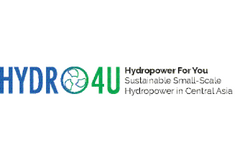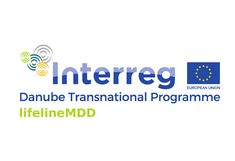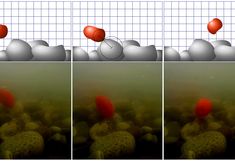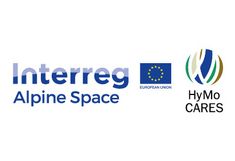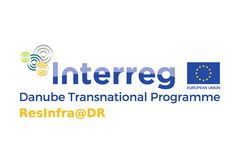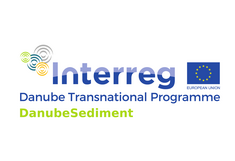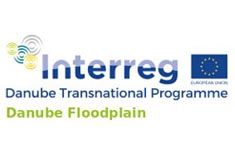Research
Selection of project-specific websites
This page contains specific presentations of selected projects.
For a complete list and short presentation of all our ongoing and completed projects, please visit our research information system FIS:
Research Information System
DanubeSediment_Q2 - Danube Sediment Balance - Sustainable, Integrated Transnational Sediment Quantity and Quality Management in the Danube River Basin

DanubeSediment_Q2 is funded by the Danube Region Programme (co-funded by the EU) and aims to improve the management of sediment quantity and quality in the Danube River Basin to achieve environmental objectives. The main output is the first Integrated Sediment Management Plan (ISMP) for the Danube River Basin. We will recommend concrete solutions and upscaling options to be taken up by International Commission for the Protection of the Danube River (ICPDR) in the next Danube River Basin Management Plan as well as Flood Risk Management Plan. To achieve this for the first time an improved and extended, combined sediment quantity and quality monitoring network and the outputs (i) new hydromorphological assessment method and (ii) sediment risk assessment method will be essential. Of central importance are the sediment management measures developed in an innovative co-design. For this reason, stakeholders are heavily involved in the discussion from the start. Their needs flow directly into the project. To develop new measures, monitoring and assessment is conducted and computer models are developed based on case studies as well as on physical model tests. Furthermore, new methods for assessing hydromorphology and the risk of the effects of a disturbed sediment balance are being developed.
The special objectives of the project are:
-
Improved sediment monitoring, data management and evaluation methods in the Danube River Basin
-
Feasibility of practical solutions to address sediment alteration being co-created with stakeholders
-
Developed transboundary Integrated Sediment Management Plan ISMP for the Danube River Basin
Further Information: https://interreg-danube.eu/projects/danubesediment-q2
Hydro4U - Hydropower For You
Hydro4U aims at demonstrating European small hydropower equipment and technologies in Central Asia thus contributing to a sustainable and climate-resilient future for the region. Eco-friendly hydropower solutions will be implemented at two demonstration sites. The project brings together 13 partners from 8 countries and is funded under the European Union’s Horizon 2020 research and innovation programme.
BOKU’s core activities in the project are to lead the analysis of unexploited small-scale hydropower potential in Central Asia. Further, BOKU plays a key role in the project team by sharing environmental research expertise. BOKU is in involved in several other Hydro4U activities aiming to achieve environmentally sustainable hydropower solutions and giving holistic decision support. The research focus of BOKU IWA lies on integral hydraulic engineering, with the following core elements: water use – water protection – protection from the water. These include research areas and expertise in renewable energy with sustainable hydropower, integrated flood risk management, (eco-) hydraulics, river research and hydraulic engineering, with an emphasis on sediment management and river morphology, river restoration as well as waterway infrastructure for inland navigation.
Further Information: https://hydro4u.eu/project/project-overview/
lifelineMDD - Protecting and restoring ecological connectivity in the Mura-Drava-Danube river corridor through cross-sectoral cooperation
Mura, Drava and Danube (MDD) form the lifeline of one of the most valuable river corridors in the Danube Basin. However, connectivity within the corridor is reduced due to human-made changes to rivers and their natural processes. While DTP-project coopMDD established a living cooperation between Protected Area managers and a Transboundary Management Programme for the planned 5-country Biosphere Reserve MDD, the knowledge base and transboundary cross-sectoral cooperation stays insufficient. This leads to unused opportunities for synergies between multiple aims in river management.
lifelineMDD addresses these issues with a cross-sectoral partnership, aiming to improve connectivity and biodiversity within the MDD river corridor by restoration of natural river dynamics. The development of a strategic integrated approach to river restoration in the transboundary bio-corridor will be based on scientific studies of bio-indicators fish and river birds and abiotic framework conditions sediment transport and climate change. A cross-sectoral learning process between nature protection and water management authorities based on pilot restoration actions will raise institutional competences and cooperation between key stakeholders. Involvement of NGOs, local and national policy levels will ensure sustainability of results by awareness raising in the local population and development of lasting stakeholder platforms.
By providing an integrated transboundary strategic framework for river restoration based on research, pilot restoration and joint learning, lifelineMDD will strongly contribute to the DTP objective of protecting and restoring ecological corridors and raise cooperation between main actors. The project contributes to close connectivity gaps defined in the EUSDR study “Ecological Connectivity in the Danube Region”, e.g. research gaps on complex ecological processes, cooperation gap between nature protection and other sectors, geographic gap on tributary rivers.
lifelineMDD project is co-funded through the Danube Transnational Programme of the European Union (ERDF and IPA funds). The project started on 1st July 2020 and lasts until the 31st December 2022. The total budget of the project is 2,987,829.19 €, divided between 12 full partners. WWF Austria as lead partner coordinates the overall project.
For news and updates follow the project on Facebook https://www.facebook.com/lifelinemdd/ or Instagram https://www.instagram.com/lifelinemdd/
For further information click here: lifelineMDD Abstract Download
PiCASSO - Particle Collisions for Arbitrary Smooth Shaped Objects - Experimental and numerical investigation: Model development and validation
Objectives
The overall project aim is to study collisions which occur in riverine systems and to develop an appropriate collision model. This requires to investigate collisions of arbitrary shaped particles at oblique angles, for diverse Stokes numbers and high Reynolds numbers.
Approach/methods
Our approach is threefold. We combine (1) cutting-edge experimental high resolution spatio-temporal 4D-PTV measurements to (2) develop a mathematical lubrication model and (3) implement a numerical collision model based on an immersed boundary method FSI code.
Wider research context
Many rivers worldwide suffer from disturbed sediment dynamics due to human and climate impacts. Understanding sediment processes in rivers is a prerequisite for developing efficient sediment management strategies. When dealing with sediment transport processes in rivers most researchers use a standard or modified form of the critical Shields parameter to predict the incipient motion of a grain size of interest. Despite the wide use of this concept, many studies reveal the apparent lack of a precise threshold value. Rather than the temporally and spatially averaged shear stress at the reach scale, instantaneous forces acting on the grain are responsible for its mobilization. Moreover, particle-particle interactions are a main contributor to sediment entrainment and should thus be explored. The interplay of a fluid (e.g. water) with a solid body (e.g. sediment grains) is modeled in the field of fluid-structure-interactions (FSI). If particle-particle collisions need to be considered additional equations have to be solved. The novel 4D-PTV method for high-resolution spatio-temporal measurements of the flow is an excellent way to study FSI problems experimentally. Collision models between spherical objects and spheroidal objects have been developed recently. Despite the fact that the key role of arbitrary shaped objects and polydisperse particles has been acknowledged in recent publications, experimental and numerical studies for high Reynolds number flows and polydisperse arbitrary shaped particles do not yet exist to the best of the authors' knowledge.
Project duration and partners
The project runs from 01.05.2020-30.04.2023.
swarm - Strengthening of master curricula in water resources management for the Wester Balkan HEIs and stakeholders
The overall broader aim of the project “swarm” is the education of experts for water resources management in the Western Balkans (WB) in line with the national and EU policies.
Specific objectives
- Improve the level of competencies and skills in Higher Education Institutions (HEI’s) by developing new and innovative master programmes in the field of water resources management (WRM) in line with the Bologna requirements and national accreditation standards by October 2021 - Design and implement seven new and up-to-date laboratories in WB partner HEIs in cooperation with EU project partners by November 2019 - Develop and implement LLL courses for the water sector in line with EU Water Framework Directive by January 2021
The project is co-funded by the Erasmus+ Programme of the European Union.
More information is available at:
http://www.swarm.ni.ac.rs/
HyMoCARES - HydroMorphological assessment and management at basin scale for the Conservation of Alpine Rivers and related Ecosystem Services
River corridors represent one of the most used and modified landscape elements in the Alps. They provide key ecosystem services, but currently many of them are at risk or significantly degraded. The project will develop a conceptual framework, and operational tools, comprising novel methods, to integrate ecosystem services in Alpine river basin planning and management, with a special focus on factors affecting river hydromorphology – including sediment continuity – while ensuring integration of local and basin scales. The project will identify actual planning, management, operational activities, where the proposed approach can be applied, and will collaborate directly with relevant actors, both public and private, in order to ensure proper transfer of project outputs, and thus a tangible real-scale impact. This project is co-financed (total funding: € 2,103,433.37) by the European Regional Development Fund through the Interreg Alpine Space programme.
Link to project website: http://www.alpine-space.eu/projects/hymocares/en/home
ResInfra@DR - Facilitating macro-regional scope and link up to socio-economic actors of Research Infrastructure in the Danube Region
In view of ever more complex and differentiated innovation and research funding mix in the Danube macroregion, coupled with the current circumstances of financial crisis that highly affects the public sector investments, the absence of adequate ex-ante review, monitoring and impact oriented assessments on STI programmes and specifically on research infrastructures (RI), is a serious bottleneck for the entire STI funding system and the innovation management cycle.
Referring to efforts to establish new research infrastructures (RI), to upgrade the existing ones or to reassess their functionality, it is evident that no specific tools or standard methodologies are available that adequately reflect the specific situation in the Danube Macro-region. Moreover, efforts to ease the utilization of RIs on regional level are necessary to prove the usefulness of proper public R&D funding and to stimulate the private actors to co-fund in future research infrastructure i.e. in private public partnerships.
ResInfra@DR aims to upgrade the knowledge of policy makers and the policy delivery organisations involved in the financing, and parent organisations arranging the operation of research infrastructures. It involves in the activities two core beneficiary groups by exploiting the broad outreach of the involved
partnership. ResInfra@DR develops (1) a dialogue focusing on important regional, national and macro regional but also EU level policy fields, the end-users of RIs. It (2) provides to the target groups special trainings, thus contribute to capacity building with an outreach to the entire macro-region and beyond the involved partnership and (3) collects a dataset of competent (and qualified) reviewers for RI assessments. Two pilot activities will focus on (4) Peer reviews of nine existing RIs and (5) Ex ante assessments of three planned RIs in the Macro Region. Dedicated dissemination and capitalisation actions contribute to policy take up and utilisation of the results.
ResInfra@DR with an overall budget of € 2.154.989,34 is running from January 2017 to June 2019 and is co-financed by the Interreg-Danube Transnational Programme of the European Regional Development Fund.
Link to the project homepage: http://www.interreg-danube.eu/approved-projects/resinfra-dr
Danube Sediment Management - Restoration of the Sediment Balance in the Danube River (DanubeSediment)
In the Danube Basin an increasing discrepancy between surplus and lack of sediment can be observed. This leads to an increase of flood risks and a reduction of navigation possibilities, hydropower production and biodiversity. Thus, sediment transport and sediment management are urgent issues, which can only be treated in a transnational basin wide approach as sediments don’t regard administrative or political borders. The lack of sediment management has been recognized by the ICPDR in the Danube River Basin Management Plan in 2009 and 2015. Thus, the main objective of this project is to improve Water and Sediment Management as well as the morphology of the Danube River. To close existing knowledge gaps, sediment data collection will be performed providing information to the sediment data analysis and will lead to a handbook on good practices of sediment monitoring methods. Furthermore, a baseline document on the Danube Sediment Balance will be prepared, which explains the problems which arise with sediment discontinuity negatively influencing flood risk, inland navigation, ecology and hydropower production. Possible answers to these problems will be provided by a catalogue of measures. The main outputs of the project are the first Danube Sediment Management Guidance comprising measures to be implemented and a Sediment Manual for the stakeholders consisting of approaches how to implement the measures, which deliver key contributions to the Danube River Basin Management Plan and the Danube Flood Risk Management Plan. By a better and sustainable sediment management in the Danube Basin, improved navigation conditions, reduced flood risks, enhanced ecological status and durable hydropower production will be obtained. Furthermore, International Stakeholder Workshop, training 100 experts, will be organized to reach the target groups and users of the project results as well as to establish an efficient interaction with them.
DanubeSediment with an overall budget of € 3.558.581,62 is running from January 2017 to June 2019 and is co-financed by the Interreg-Danube Transnational Programme of the European Regional Development Fund.
Up-to-date information can be found under www.interreg-danube.eu/danubesediment
SEDECO - Sediments, ecosystem services and interrelation with floods and droughts in the AT-CZ border region
The Thaya River forms the border between AT and CZ,and both countries profit from its use (e.g. energy production, recreation, fisheries). But the use leads to negative impacts on the river system such as channelization and flood plain disconnection of the river. These impacts initiate a modification of the sediment transport causing e.g. sedimentation in reservoirs and increasing flood risk. Meander cut offs trigger ecosystem degradation and destabilization of the aquatic habitats (e.g. spawning places) and consequently have a negative influence on biodiversity. This affects together with floods and droughts - intensified by climate change - the functioning of ecosystems, increasing vulnerability and a decline in ecosystem services provided by the river.
Therefore the aim of SEDECO is to promote ecosystem services and biodiversity as well as to reduce the impacts of floods and droughts by the derivation of targeted and efficient green infrastructures. The new Hydraulic Engineering Laboratory HEL as open research center will, together with joint monitoring and modelling, form the basis for optimized green infrastructures. This involves an improved knowledge about the Thaya river system including a sustainable reservoir sediment management strategy helping to minimize flood and drought risk. Furthermore SEDECO aims to improve the morphodynamics in cross border meander reaches and of preserved natural or restored river banks, positively influencing ecosystem services and related biodiversity especially regarding fish, macrozoobenthic species and birds.
The key outputs are the New Hydraulic engineering laboratory (HEL), a sustainable sediment management strategy for the Nove Mlyny reservoir and a guideline for sustainable meander and riverbank restoration/preservation to improve ecosystem services and reduce flood and drought risk in the cross border region. The main beneficiaries of the project outputs are (i) the natural environment, the Thaya river biodiversity and the National Parks, (ii) Water Management Authorities in AT (via donau, Lower Austria) and CZ (Povodi Moravi), (iii) persons interested in fisheries and wildlife, (iv) experts, students and researchers, (v) people in the cross border region, affected by floods and droughts, (vi) general public.
Since rivers are not restricted by administrative and political borders and floods, droughts, sediments, fish etc. are moving across borders a pure national/regional/local approach is not able to protect and manage fluvial systems. The cross border cooperation is the only way to guarantee a sustainable solution for the problems addressed in SEDECO. In SEDECO the new approach consists of a joint development of monitoring, physical and numerical modelling of green infrastructures including a common strategic working and realisation concept developed in close cooperation between all partners.
SEDECO is running from April 2016 to Dezember 2020 and is co-financed by the Interreg Va Austria – Czech Republic Programme of the European Regional Development Fund.
Link to the project homepage: https://www.at-cz.eu/at/ibox/pa-2/atcz28_sedeco
SEDDON II - Sediment Research and Management at the Danube River II
Sediments and sediment management play a fundamental role in the management of rivers and their quality. The Upper (Austria) and Middle Danube (Hungary) are facing sediment related problems (e.g. river bed erosion) impacting the ecological condition, flood risk management, navigation and hydropower. Since water and sediments don’t regard borders, a cross border cooperation is needed in the area of field monitoring, numerical and physical modelling and practical river engineering measures. SEDDON II continues the basic achievements reached in SEDDON and focuses on the implementation of the suggested improvements. SEDDON II aims to improve knowledge and knowledge transfer from science to river management. Studies based on longer-term programs will lead to targeted and efficient measures in order to improve the ecological status and flood risk management. The key outputs of the project are i) a modern hydraulic engineering laboratory (HEL), being a unique research infrastructure with a discharge of up to 10 m³/s, allowing the study of basic processes and interrelations with river engineering measures; ii) a joint monitoring and modelling system, including the set up of new sediment monitoring stations and an expeditionary river survey system (ERiSS) in the HU section of the Danube, similarly to the station already existing in AT, and a comprehensive modelling throughout the project implementation, covering low, mean and high flow situations; iii) a guideline for joint river engineering measures based on the combination of large scale physical modelling with new numerical modelling using data from field monitoring. By using the new HEL an innovative infrastructure is available for exchanging knowledge between AT and HU, including experts, students and the public (also in the framework of the EUSDR flagship project DREAM). From the outcomes of SEDDON II the entire population along the Danube River will benefit.
SEDDON II is running from April 2016 to Dezember 2020 and is co-financed by the Interreg Va Austria – Hungary Programme of the European Regional Development Fund.
Link to the project homepage: http://www.interreg-athu.eu/en/seddon2/
DREAM RRMC VIENNA (hydraulic engineering laboratory)
The aim of the project is the construction of a research infrastructure consisting of a modern hydraulic engineering laboratory (RRMC) in Vienna with an in Europe unique laboratory discharge of up to 10 m³ / s without pumping. This represents the successful partial implementation of Activity 1 of the EUSDR DREAM (Danube River REsearch and Management) flagship project.
The purpose of the RRMC is to improve the understanding of processes occurring in rivers, to develop mathematical models for process description, to predict the impact of river engineering measures and to develop innovative hydraulic engineering methods to improve navigation, hydropower, flood protection and ecology. In addition, in the new laboratory, problem-solving measures in various hydrological topics will be developed (for example accumulation of sediment, depth of the waterway, restoration of riverbanks, stabilization of the riverbed, network of waterways).
The hydraulic engineering laboratory will be built between the Danube and the Danube Canal, is 100m long and 25m wide. The "Main Channel" in the basement is the heart of the hydraulic engineering laboratory. The large discharge (up to 10 m³ / s) enables practice-oriented model experiments, as a very large model scale up to 1: 1 is possible, which is in particular crucial in sediment transport experiments.
The project runs from April 2016 to December 2020 and is co-financed by the European Regional Development Fund through the “Investment for growth and jobs” program.
DREAM SK-AT Danube River Research and Management in Slovakia and Austria
The aims are to establish joint research facilities, to enhance knowledge transfer and to develop innovative monitoring and modelling tools in the SK-AT border region. By enhancing knowledge transfer and capacity building between research bodies and universities, the project will lead to an improved cooperation and exchange of expertise between research and innovation actors using newly constructed and upgraded research infrastructures (RI). New monitoring stations as well as innovative monitoring techniques (e.g. operative boat) and modelling tools concerning hydrodynamics, sediment transport, morphodynamics, ecological parameters and remote sensing technologies in river and wetland science will lead to high quality and comparable data derived at the Danube River in the project reaches (cross border region and adjacent reaches). A guidance document of monitoring and modelling tools will be published and available for the target groups. In SK (VÚVH) the hydraulic engineering laboratory (discharge 1,5 m³/s) will be modernized and upgraded according to the state of the art together with laboratory of geoinformatics and advanced river remote sensing (ILE SAS). In AT a hydraulic engineering laboratory will be constructed with 10 m³/s free flowing discharge. By using these RIs, the scientific basis for improving the Danube river management between Vienna and Bratislava will be developed, being available for target groups working in navigation, flood risk management, ecology, hydropower and drinking water supply. Furthermore, a close exchange of undergraduate and doctoral students and teachers between BOKU, VUVH and ILE SAS will be initiated and the research facilities will be jointly used for common teaching and research activities, also beyond the lifetime of the project.
Further information is available at: https://dream-sk-at.jimdosite.com/
Reducing the flood risk through floodplain restoration along the Danube River and tributaries (Danube Floodplain)
The first Danube Flood Risk Management Plan, as well as the legal bases of the European Water Framework Directive, the Fauna-Flora-Habitat Directive and the Birds Directive lead to the introduction of a Danube-wide integrative flood risk management, with a special view on the flood disasters of the recent decades.
The goal of Danube Floodplain is to develop a cross-river basin strategy and roadmap that will promote the protection and / or the optimal use of existing as well as the reconnection of isolated or lost retention areas / floodplains.
For this purpose extensive investigations at the retention areas of the Danube are carried out with hydraulic models using the FEM (Flood Evaluation Matrix) in order to obtain the inventory of the present situation. The existing and formerly existing retention areas will be ranked using the FEM. At selected pilot reaches, the FEM will be further developed and applied in terms of biodiversity and cost-benefit analyses, in order to provide the stakeholders involved with a basis for their further action.
Danube Floodplain with an overall budget of € 3.672.655,88 is running from June 2018 to November 2020 and is co-financed by the Interreg-Danube Transnational Programme of the European Regional Development Fund. Projekt extension until November 2021.
Up-to-date information can be found under http://www.interreg-danube.eu/approved-projects/danube-floodplain
PRESS RELEASE - 04. November 2021: a brief overview on the closure of the project

